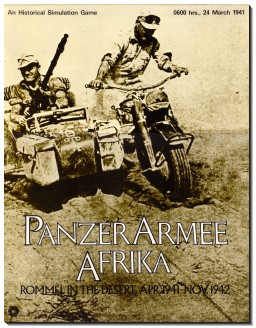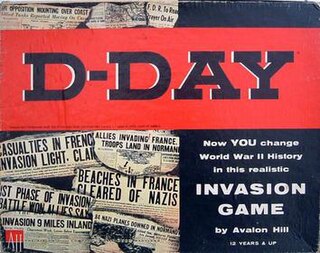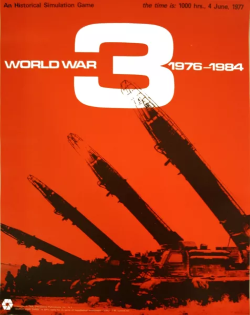
PanzerArmee Afrika, subtitled "Rommel in the Desert, April 1941 - November 1942", is a board wargame published by Simulations Publications, Inc. (SPI) in 1973 that simulates the World War II North African Campaign that pitted the Axis forces commanded by Erwin Rommel against Allied forces. The game was revised and republished in 1984 by Avalon Hill.

1776, subtitled "The Game of the American Revolutionary War", is a board wargame published by Avalon Hill in 1974 that simulates the American Revolutionary War. Its release was timed to coincide with the bicentenary of the Revolution, and for several years was a bestseller for Avalon Hill.

D-Day is a board wargame published by Avalon Hill in 1961 that simulates the six months of the European Campaign of World War II from the Normandy Invasion to the crossing of the Rhine. It was the first wargame to feature the now ubiquitous hex grid map and cardboard counters, and was revised and re-released in 1962, 1965, 1971, 1977 and 1991.

Afrika Korps is a board wargame published by Avalon Hill in 1964 and re-released in 1965 and 1978 that simulates the North Africa Campaign during World War II.

Alexander the Great is a board wargame first published by Guidon Games in 1971 that simulates the Battle of Arbela in 331 BCE, also known as the Battle of Gaugamela. A revised edition was published by Avalon Hill in 1974. Both editions of the game were notable for having what one critic described as "one of the ugliest maps ever to curse a war game."

Jedko Games is an Australian importer/wholesaler of games, jigsaws, playing cards, wooden toys, board games, traditional games and puzzles. It was originally a publisher of original games and Australian editions of overseas wargames.

Stalingrad is a strategic-level board wargame published by Avalon Hill in 1963 that simulates the first 24 months of the war between Germany and the Soviet Union during World War II. As one of the first board wargames it was extensively played and discussed during the early years of the wargaming hobby.

Tobruk, subtitled "Tank Battles in North Africa 1942", is a board wargame published by Avalon Hill in 1975 that simulates tank combat in North Africa during World War II.

El Alamein: Battles in North Africa, 1942 is a board wargame published by Simulations Publications Inc. (SPI) in 1973 that simulates the final four months of the North African campaign during World War II.

Frederick the Great, subtitled "The Campaigns of The Soldier King 1756–1759", is a board wargame published by Simulations Publications Inc. (SPI) in 1975 that simulates several of the campaigns of Frederick the Great in Central Europe during the Seven Years' War. When SPI ran into financial difficulties, they sold the rights to the game to Avalon Hill, who produced a second edition in 1982.

Kasserine Pass, in some editions subtitled "The Baptism of Fire", is a board wargame published by Conflict Games in 1972 that simulates the Battle of Kasserine Pass during the North African Campaign of 1942, when inexperienced American forces were attacked by the battle-hardened Afrika Korps under the command of Erwin Rommel. The game was the first created by noted game designer John Hill.

Eagle Day: The Battle of Britain is a board wargame published by Histo Games in 1973 that simulates the Battle of Britain. Reviewers noted its marked similarity to previously published wargames The Battle of Britain, and Luftwaffe, but found Eagle Day to be inferior to both.

The Fall of Tobruk is a board wargame published by Conflict Games in 1975 that simulates the Second Battle of Tobruk during World War II.

Normandy: The Invasion of Europe 1944 is a board wargame published by Simulations Publications Inc. (SPI) in 1969 that simulates the D-Day landings on the beaches of Normandy, and the six days that followed as the German forces tried to prevent an Allied break-out. A second revised edition was published in 1971

A Mighty Fortress, subtitled "Reformation and Counter-Reformation, 1532-1555", is a board wargame published by Simulations Publications Inc. (SPI) in 1977 that simulates the political and religious wars of the Reformation and Counter-Reformation that enveloped Europe in the 16th century. The title is taken from a famous hymn by Martin Luther.

Assault on Tobruk, subtitled "Rommel Triumphant, 20 June 1942," is a board wargame published by Simulations Canada in 1980 that simulates the North African Battle of Tobruk during World War II. Compass Games later reissued a new edition of the game.

Breakout & Pursuit: The Battle for France, 1944 is a board wargame published by Simulations Publications Inc. (SPI) in 1972 that simulates the breakout of Allied forces from Normandy during World War II, and their subsequent pursuit of retreating German forces.

World War 3: 1976–1984 is a Cold War-era board wargame published by Simulations Publications Inc. (SPI) in 1975 that simulates a hypothetical non-nuclear war for control of the world set in the 1970s. The game sold very well, and was one of SPI's top-selling games for almost a year.

The African Campaign is a board wargame published by the Australian game company Jedko Games in 1973 that simulates the North African Campaign during World War II. The game design was based on Avalon Hill's popular wargame Afrika Korps, but Avalon Hill recognized some improvements had been made to the game, and became the North American distributor of Jedko games including this one.

Waterloo is a Napoleonic board wargame published by Avalon Hill in 1963 that simulates the Battle of Waterloo. It was one of the first board wargames produced and despite its lack of historicity and complexity, it still received positive comments more than twenty years later as a fun and playable game, and remained in Avalon Hill's catalogue until 1990.




















